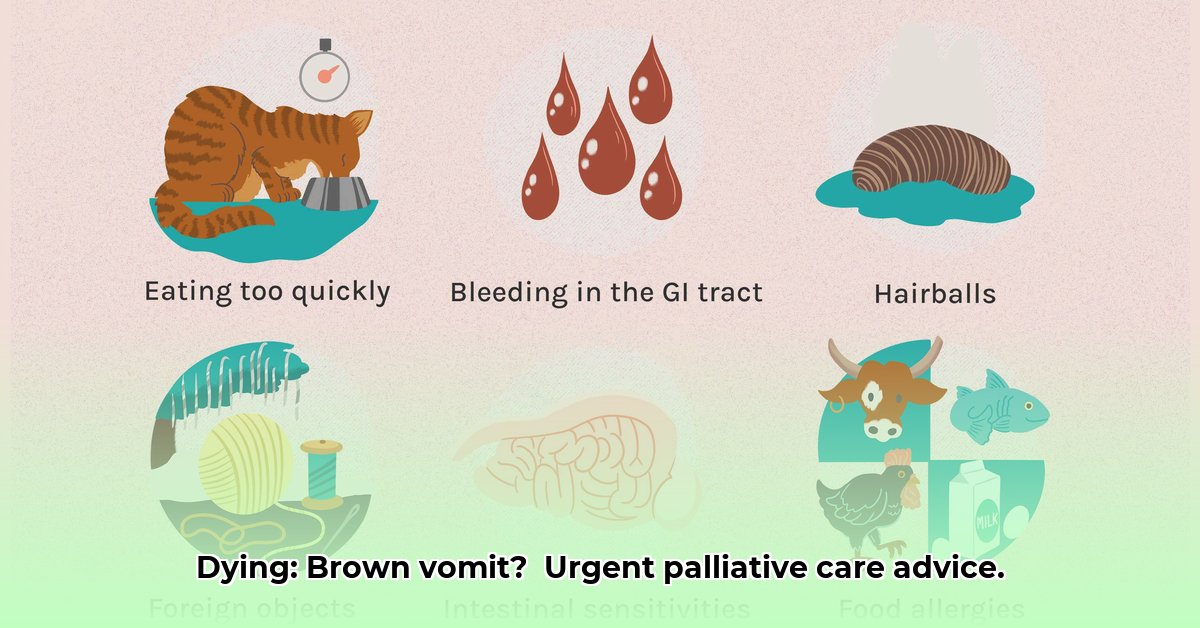It’s incredibly distressing to witness a loved one vomiting brown liquid, especially as they approach the end of life. This guide aims to provide clarity and support during this challenging time. We’ll delve into the potential causes of brown vomit, particularly in individuals with advanced illnesses such as cancer, and offer practical strategies for managing nausea and vomiting. For more information on antiemetic drugs, see this helpful resource. Whether you’re a family member, caregiver, or healthcare professional, this resource offers valuable insights and information to alleviate discomfort and enhance comfort, ultimately prioritizing the best possible quality of life for your loved one.
End of Life Vomiting Brown Liquid: Understanding and Managing This Difficult Symptom
Insights on gastrointestinal bleeding, medication considerations, and symptom relief
Nausea and vomiting are unfortunately common and distressing symptoms near the end of life, particularly for those battling cancer. These symptoms significantly impact a person’s well-being. The appearance of brown liquid in vomit can be especially alarming and warrants prompt attention. Let’s examine this symptom and explore strategies for effective management.
Understanding Why Brown Vomit Happens
Explaining the Causes, Including Gastrointestinal Bleeding and Medication Side Effects
The color of vomit can offer vital clues to healthcare professionals. While various factors can induce nausea and vomiting, brown vomit, often resembling coffee grounds, may suggest the presence of blood in the digestive system. This occurs when blood has been partially digested by stomach acids. It is important to understand that this is not always the case; however, it is a symptom that health professionals need to determine quickly. In addition, medications, intestinal blockages, or the underlying illness may result in brown vomit. A comprehensive assessment is essential for accurate diagnosis.
When to Call for Help – Don’t Delay!
Recognizing Warning Signs and Seeking Immediate Medical Attention
If your loved one experiences brown vomit at the end of life, it is crucial to contact their healthcare provider or hospice team without delay. Swift intervention is essential. It’s particularly important to seek immediate help if the vomiting is persistent, severe, or accompanied by concerning symptoms like dizziness, weakness, or shortness of breath. Early intervention can significantly improve comfort and symptom management.
Managing Nausea and Vomiting: A Team Approach
Emphasizing Personalized Patient Care and the Importance of a Multidisciplinary Strategy
Managing nausea and vomiting at the end of life requires a personalized approach. It typically involves a combination of medication and supportive care strategies tailored to the individual’s needs. What proves effective for one person may not be as beneficial for another.
Step 1: Identifying the Underlying Cause: The healthcare provider will conduct a comprehensive evaluation to determine the root cause of the nausea and vomiting. This may involve a thorough review of the patient’s medical history, a physical examination, and possibly diagnostic tests.
Step 2: Medications for Symptom Relief: Anti-nausea medications can be highly effective in controlling nausea and vomiting. The doctor will prescribe the most appropriate medication based on the patient’s overall health status and existing medications, adjusting the dosage as necessary to maximize comfort while minimizing side effects.
Step 3: Supportive Care – Enhancing Comfort: In addition to medication, several non-pharmacological measures can help alleviate nausea and enhance comfort:
- Serving small, frequent meals instead of large ones.
- Opting for bland, easily digestible foods.
- Avoiding strong odors that may trigger nausea.
- Staying adequately hydrated by sipping fluids regularly.
- Finding a comfortable resting position.
- Utilizing relaxation techniques like deep breathing or meditation.
Step 4: Open Communication: Transparent communication with the healthcare team is paramount. Report any changes or worsening of symptoms promptly. Don’t hesitate to ask questions or voice concerns. The healthcare team is there to provide support and guidance throughout this process.
The Important Role of Caregivers
Highlighting the Support Caregivers Provide and the Importance of Caring for Themselves
Caregivers play a vital role in supporting loved ones experiencing brown vomit. Providing comfort, administering medication as prescribed, and offering emotional support are all crucial. Caring for someone during this time can be physically and emotionally draining, so it’s imperative for caregivers to prioritize their own well-being. Numerous resources are available to support caregivers, including hospice and palliative care organizations that offer valuable resources, counseling, and support groups.
Finding Peace and Comfort: It’s Possible
Reassuring Readers That Comfort and Dignity Are Achievable Goals
While experiencing brown vomit at the end of life can be incredibly distressing, it’s essential to remember that you’re not alone. The primary focus should be on ensuring comfort and managing symptoms effectively. The healthcare team is dedicated to providing the best possible care, helping patients find peace and dignity. Support is readily available, and improving quality of life remains the top priority. Comfort and peace are attainable with the right support. Ongoing research continues to advance care and treatment options for end-of-life symptoms, offering hope and a path toward a more peaceful transition.
How to Compare Antiemetic Drug Efficacy in End-of-Life Cancer Care
A Practical Guide for Navigating Pharmaceutical Options
Managing nausea and vomiting at the end of life presents a significant challenge. Understanding available treatment options is crucial. This guide aims to help you navigate the complexities of antiemetic medications in palliative care.
Key Takeaways:
- Multiple types of anti-nausea medications exist, and combining them often yields the best outcomes.
- Novel medications offer promising benefits regarding ease of use and effectiveness, but further research is needed.
- The most suitable medication depends on individual factors, including existing health conditions.
- Engage in open discussions with the doctor or palliative care team to explore your options and address any concerns.
Understanding the Challenge of End-of-Life Nausea and Vomiting
Exploring the underlying causes and complexities of advanced cancer-induced nausea
Nausea and vomiting in advanced cancer can stem from various sources, including the cancer itself, treatments such as chemotherapy, and disease progression. In some instances, vomit may appear dark brown. While this doesn’t necessarily indicate a critical issue, it’s essential to promptly report it to the medical team for assessment.
Types of Antiemetic Medications
Providing a Comprehensive Pharmaceutical Guide for Nausea Treatment
Several classes of antiemetic medications target different systems in the brain and body that trigger nausea and vomiting. Common categories include:
- 5-HT₃ receptor antagonists: These medications block serotonin receptors involved in nausea. Ondansetron (Zofran) is a widely recognized example.
- NK₁ receptor antagonists: These agents block other receptors implicated in the nausea pathway. Aprepitant (Emend) is often used alongside chemotherapy.
- Corticosteroids: These medications reduce inflammation and can effectively alleviate nausea. Dexamethasone is commonly prescribed.
- Dopamine antagonists: These medications block dopamine receptors in the brain. Metoclopramide (Reglan) is one such example.
- Novel agents: Newer medications like olanzapine and netupitant/palonosetron offer innovative strategies for managing nausea.
How to Compare Antiemetic Drug Efficacy in End-of-Life Cancer Care: A Practical Guide
Providing a Systematic Approach to Comparing Nausea Medications
Selecting the right antiemetic requires a collaborative approach. Your doctor will consider several key factors:
Step 1: Discuss Symptoms and Medical History: Provide detailed information about the severity of the nausea and vomiting, as well as any triggers. Describe the appearance of the vomit, including color and consistency. Accurate information is crucial for proper assessment.
Step 2: Consider Cancer Type and Treatment: These factors are critical, since treatments may induce specific types of nausea and vomiting.
Step 3: Evaluate Potential Drug Interactions: Given that patients often take multiple medications, the doctor must assess potential interactions to prevent adverse effects.
Step 4: Assess Potential Side Effects: All medications carry potential side effects. Discuss these openly with the doctor. For example, olanzapine may cause drowsiness.
Weighing the Pros and Cons of Different Options
A Decision-Making Framework for Medication Selection
No “one-size-fits-all” solution exists. The benefits of one medication may outweigh its drawbacks, while another may offer a different optimal balance. Here’s a structured approach to making informed decisions:
| Medication Type | Pros | Cons |
|---|---|---|
| 5-HT₃ Receptor Antagonists | Often effective and well-established | May not work for all patients; can cause constipation or headaches |
| NK₁ Receptor Antagonists | Highly effective, particularly in combination therapies | Can be more expensive, with potential side effects |
| Corticosteroids | Possess potent anti-inflammatory and anti-nausea effects | Prolonged use can lead to side effects, such as increased blood sugar levels |
| Novel Agents (e.g., Olanzapine) | May be beneficial for nausea unresponsive to other treatments | Can cause drowsiness or other side effects; more research is warranted regarding long-term effects |
The doctor is the best resource for determining the optimal antiemetic strategy tailored to your specific circumstances.
Palliative Care Strategies for Managing Nausea in Advanced Cancer
A Comprehensive Approach to Enhancing Comfort and Minimizing Distress
Key Takeaways:
- Nausea and vomiting are prevalent and distressing symptoms in advanced cancer.
- Palliative Care Strategies for Managing Nausea in Advanced Cancer emphasize a
- Japanese Lunch Bag Does Double Duty as Bento Carrier and Tote - December 4, 2025
- Your Perfect Bento Box Bag For Fresh And Tidy Meals - December 2, 2025
- Korean Meal Prep Made Easy For Delicious Weekday Meals - December 1, 2025










